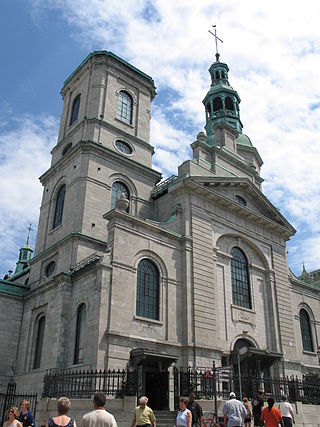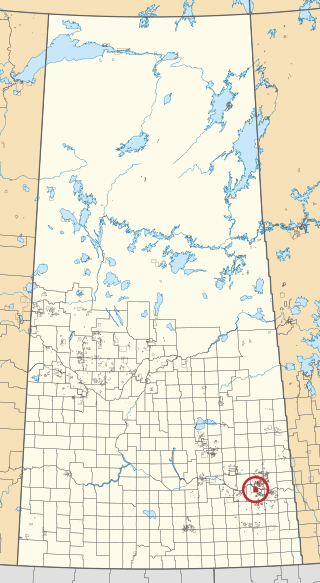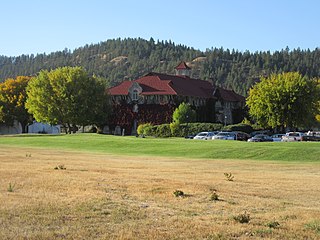
The Canadian Catholic Church, or Catholic Church in Canada, is part of the worldwide Catholic Church, and has a decentralised structure, meaning each diocesan bishop is autonomous but under the spiritual leadership of the Pope and the Canadian Conference of Catholic Bishops. As of 2021, it has the largest number of adherents to a Christian denomination and a religion in Canada, with 29.4% of Canadians being adherents according to the census in 2021. There are 73 dioceses and about 7,000 priests in Canada. On a normal Sunday, between 15 and 25 percent of Canada's Catholics attend Mass.

The Missionary Oblates of Mary Immaculate (OMI) is a missionary religious congregation in the Catholic Church. It was founded on January 25, 1816, by Eugène de Mazenod, a French priest later recognized as a Catholic saint. The congregation was given recognition by Pope Leo XII on February 17, 1826. As of January 2020, the congregation was composed of 3,631 priests and lay brothers usually living in community. Their traditional salutation is Laudetur Iesus Christus, to which the response is Et Maria Immaculata. Members use the post-nominal letters, "OMI".

The CanadianIndian residential school system was a network of boarding schools for Indigenous peoples. The network was funded by the Canadian government's Department of Indian Affairs and administered by Christian churches. The school system was created to isolate Indigenous children from the influence of their own culture and religion in order to assimilate them into the dominant Canadian culture. Over the course of the system's more than hundred-year existence, around 150,000 children were placed in residential schools nationally. By the 1930s, about 30 percent of Indigenous children were attending residential schools. The number of school-related deaths remains unknown due to incomplete records. Estimates range from 3,200 to over 30,000, mostly from disease.

An unmarked grave is one that lacks a marker, headstone, or nameplate indicating that a body is buried there. However, in cultures that mark burial sites, the phrase unmarked grave has taken on a metaphorical meaning.

The Kamloops Indian Residential School was part of the Canadian Indian residential school system. Located in Kamloops, British Columbia, it was once the largest residential school in Canada, with its enrolment peaking at 500 in the 1950s. The school was established in 1890 and operated until 1969, when it was taken over from the Catholic Church by the federal government to be used as a day school residence. It closed in 1978. The school building still stands today, and is located on the Tk’emlúps te Secwépemc First Nation.

Vital-Justin Grandin was a Roman Catholic priest and bishop labelled as a key architect of the Canadian Indian residential school system by contemporary mainstream and Catholic news sources, which has been considered an instrument of cultural genocide. In June 2021, this led to governments and private businesses to begin removing his name from institutions and infrastructure previously named for him. He served the Church in the western parts of what is now Canada both before and after Confederation. He is also the namesake or co-founder of various small communities and neighbourhoods in what is now Alberta, Canada, especially those of francophone residents.

Cowessess First Nation is a Saulteaux First Nations band government in southern Saskatchewan, Canada. The band's main reserve is Cowessess 73, one of several adjoining Indigenous communities in the Qu'Appelle Valley. The band also administers Cowessess 73A, near Esterhazy, and Treaty Four Reserve Grounds 77, which is shared with 32 other bands.
Grouard, also known as Grouard Mission, is a hamlet in northern Alberta within Big Lakes County. It was previously an incorporated municipality between 1909 and 1944.
St. Mary's Indian Residential School was the name of two Indian residential schools in Mission, British Columbia. The first was operated by the Roman Catholic Church of Canada, and the second was operated by the Canadian federal government. Approximately 2,000 children attended the schools while they were in operation, most of them Stó:lō.

Qu'Appelle Indian Residential School (Q.I.R.S.) or Qu'Appelle Industrial School was a Canadian residential school in the Qu'Appelle Valley, Saskatchewan. As one of the early residential schools in western Canada, it was operated from 1884 to 1969 by the Roman Catholic Church for First Nations children and was run by the Missionary Oblates of Mary Immaculate and the Grey Nuns. As of November 8, 2021 Star Blanket Cree Nation started searching for unmarked graves using ground-penetrating radar.

The St. John's Indian Residential School, also known as the Chapleau Indian Residential School, was a Canadian Indian Residential School operated by the Anglican Church of Canada from 1907 to 1948 in Chapleau, Ontario.

Cowessess 73 is an Indian reserve of the Cowessess First Nation in Saskatchewan. It is 13 kilometres northwest of Broadview. In the 2016 Canadian Census, it recorded a population of 540 living in 190 of its 214 total private dwellings. In the same year, its Community Well-Being index was calculated at 63 of 100, compared to 58.4 for the average First Nations community and 77.5 for the average non-Indigenous community.

The Kootenay Indian Residential School, composed of the St. Eugene's and St. Mary's mission schools, was a part of the Canadian Indian residential school system and operated in Cranbrook, British Columbia between 1890 and 1970. The school, run by the Missionary Oblates of Mary Immaculate of the Roman Catholic Church, first opened in 1890. It was replaced by an industrial school in 1912 that continued to operate until it was closed in 1970. Between 1912 and 1970, over 5,000 children from across British Columbia and Alberta attended the school. The building has been home to the St. Eugene Golf Resort and Casino since 2000.

The Kuper Island Indian Residential School, also known as Kuper Island Indian Industrial School, was a Canadian Indian residential school located on Kuper Island, near Chemainus, British Columbia, that operated from 1889 to 1975. The school was operated by the Roman Catholic Church, with funding from the Department of Indian Affairs.

The Brandon Indian Residential School was a former school located in Brandon, Manitoba. It was a part of the former Canadian Indian residential school system.

The Marieval Indian Residential School was part of the Canadian Indian residential school system. Located on the Cowessess 73 reserve in Marieval, Saskatchewan, it operated from 1898 to 1997. It was located in Qu'Appelle Valley, east of Crooked Lake and 24 km (15 mi) north of Broadview.
The Canadian Indian residential school gravesites are burial areas for an unknown number of students that died while attending the Canadian Indian residential school system. Comparatively few cemeteries associated with residential schools are explicitly referenced in surviving documents; however, the age and duration of the schools suggests that most had a cemetery associated with them. Most cemeteries were unregistered, and as such the locations of many burial sites of residential school children have been lost. The Truth and Reconciliation Commission of Canada has called for "the ongoing identification, documentation, maintenance, commemoration, and protection of residential school cemeteries or other sites at which residential school children were buried."
The Muscowequan Indian Residential School was a school within the Canadian Indian residential school system that operated on the lands of the Muskowekwan First Nation and in Lestock, Saskatchewan, from 1889 to 1997.

A series of vandalizations, church arsons, and suspicious fires in June and July 2021 desecrated, damaged, or destroyed 68 Christian churches in Canada. Coincident with fires, vandalism and other destructive events damaged churches in Canada and the United States, primarily in British Columbia. Of these, 25 were the results of fires of all causes. Canadian government officials, church members, and Canadian Indigenous leaders have speculated that the fires and other acts of vandalism have been reactions to the reported discovery of over 1,000 unmarked graves at Canadian Indian residential school sites in May 2021.
St. Augustine's Indian Residential School was a school in Sechelt, British Columbia, Canada, from 1904 to 1975, which was part of the Canadian Indian residential school system. Former pupils include actor Pat John who played in The Beachcombers for 19 years. The school was within 0.25 miles (0.40 km) of the commercial centre of Sechelt, and was also known as Sechelt Residential School, Sechelt Industrial School and Our Lady of Lourdes.















